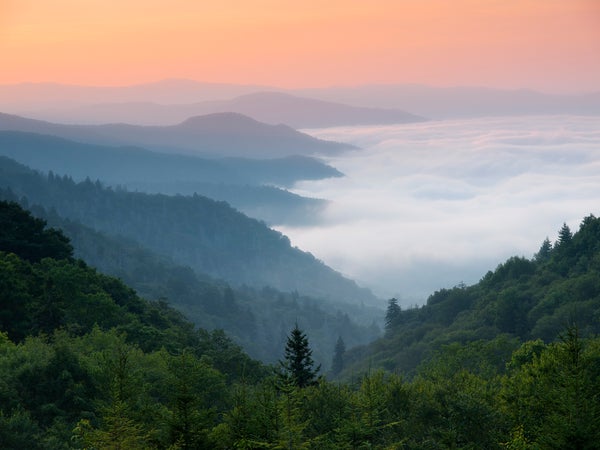How Temperate Forests Could Help Limit Climate Change
People understand how saving tropical forests is good for the planet, but temperate forests are equally indispensable in fighting climate change

Blue Ridge Parkway, Great Smoky Mountains National Park, North Carolina.
Itai MinovitzGetty Images
Much of the conservation and climate change spotlight falls on tropical forests. Given this, people might forget that forests in the temperate areas—those found in large parts of North America, Europe and higher latitudes in Asia and Australia—also have the power to help limit climate change. As much as preserving tropical rainforests is indispensable to climate progress, policy makers cannot ignore the critical role of temperate forests. This Earth Week, we must turn our attention—and dollars—to these swaths of trees, or face the loss of an important tool in managing global warming.
Temperate forests represent about 25 percent of Earth’s arboreal lands. As temperatures have changed, temperate trees face threats from of harmful invasive pests from other regions, loss of forest lands from urban sprawl and farmland expansion, and catastrophic wildfires that are becoming more common and severe. At the same time, they are some of the most well-studied and well-understood ecosystems on Earth—giving us a chance to put science into action in the service of climate progress.
To save temperate forests, we need to reduce land-clearing for housing and agriculture, then allow trees to regrow where they have been removed, and thoughtfully manage each acre to promote ecological health. To understand how reforestation and better management will aid in climate restoration, look to forest lands of the eastern U.S.
On supporting science journalism
If you’re enjoying this article, consider supporting our award-winning journalism by subscribing. By purchasing a subscription you are helping to ensure the future of impactful stories about the discoveries and ideas shaping our world today.
Between the time of European settlement and the early 20th century, at least 300 million acres of temperate forests in the U.S. were cleared for agriculture and timber—an area three times the size of California. This loss was especially concentrated in the East. But as agriculture moved to other parts of the country, abandoned farm fields throughout the region returned to forest largely through natural regeneration. Eastern forests continue to recover and are currently removing about 34 megatonnes of CO2 per year.
But efforts to restore forests won’t matter if we don’t stop harmful pests like the emerald ash borer, hemlock woody adelgid and Asian longhorn beetle—hitchhikers to the U.S. from other parts of the world. Each of them is ravaging native tree species in the eastern US. Most invasive pests arrive on U.S. shores in container ships and airplanes; the federal government needs to do much more to inspect cargo and intercept pests at our ports of entry.
But we believe the greatest emerging threat to temperate forests is catastrophic wildfire— wildfires that occur outside normal historic frequency and severity. Ironically, widespread fire suppression, especially in dry forests in the West, has allowed a build-up of dangerous fuel such as deadwood and dense regeneration. These fuels, combined with climate change-induced drought, have led to increasingly frequent and severe fires that kill enormous numbers of trees and spew what we calculate is up to 230 megatonnes of CO2 to the atmosphere in bad fires years in the United States.
The effects of these sorts of fires have been most stark in the western U.S., Canada, and Australia, but they are also becoming more troublesome in southern Europe and Chile. The conundrum is that fire can be beneficial and restorative, but it has to be done right. We need to thin out understory trees and strategically apply prescribed fire and cultural burns—those led by Indigenous practitioners steeped in historic fire management practices. In some cases, it involves fire managers letting wildfire burn at lower intensity and when weather conditions allow—without heavy fire suppression tactics.
These treatments also reduce stress on the remaining trees. They help combat large-scale insect damage, another phenomenon in western North American forests where, for example, bark beetles kill large numbers of trees. Recent investments through President Biden’s Inflation Reduction Act and Bipartisan Infrastructure Law provide an opportunity to demonstrate ecological thinning and beneficial fire at scale.
We need to protect and better care for the few temperate forests that still contain stands of very old trees. These old forests are some of the most carbon-dense ecosystems, harbor unique biodiversity and offer distinctive opportunities for recreation and respite. As such, governments and landowners must make sure middle-aged forests that regrew after cutting are stewarded into the old-growth forests of tomorrow. President Biden has taken important steps in this direction as well, by instituting, for the first time, rules to protect and steward old-growth forests on federal lands across the U.S.
Recent Environmental Defense Fund research shows that conserving and restoring temperate forests, alongside tropical forests, are among the most scientifically sound nature-based climate actions. The U.S. is taking important steps to capitalize on these opportunities, but more needs to be done. We need to take advantage of current public funding for forest conservation and stewardship and, at the same time, promote private investment to support restorative measures and sustainable forestry to capture the climate potential of temperate forests in the U.S. and elsewhere.
This is an opinion and analysis article, and the views expressed by the author or authors are not necessarily those of Scientific American.

